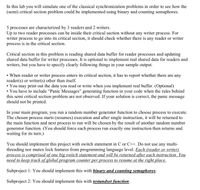
Database System Concepts
7th Edition
ISBN: 9780078022159
Author: Abraham Silberschatz Professor, Henry F. Korth, S. Sudarshan
Publisher: McGraw-Hill Education
expand_more
expand_more
format_list_bulleted
Question
Please complete in C++, simulate multithreading using switch statements in the main and each reader or writer is comprised of a big switch statement.

Transcribed Image Text:In this lab you will simulate one of the classical synchronization problems in order to see how the
(semi) critical section problem could be implemented using binary and counting semaphores.
5 processes are characterized by 3 readers and 2 writers.
Up to two reader processes can be inside their critical section without any writer process. For
writer process to go into its critical section, it should check whether there is any reader or writer
process is in the critical section.
Critical section in this problem is reading shared data buffer for reader processes and updating
shared data buffer for writer processes. It is optional to implement real shared data for readers and
writers, but you have to specify clearly following things in your sample output.
• When reader or writer process enters its critical section, it has to report whether there are any
reader(s) or writer(s) other than itself.
• You may print out the data you read or write when you implement real buffer. (Optional)
• You have to include “Panic Messages" generating function in your code when the rules behind
this semi critical section problem are not observed. If your solution is correct, the panic message
should not be printed.
In your main program, you run a random number generator function to choose process to execute.
The chosen process starts (resumes) execution and after single instruction, it will be returned to
the main function and next process to run will be chosen by the result of another random number
generator function. (You should force each process run exactly one instruction then returns and
waiting for its turn.)
You should implement this project with switch statement in C or C++. Do not use any multi-
threading nor mutex lock features from programming language level. Each (reader or writer)
process is comprised of one big switch statement and will be returned after each instruction. You
need to keep track of global program counter per process to resume at the right place.
Subproject 1: You should implement this with binary and counting semaphores.
Subproject 2: You should implement this with testandset function.
Expert Solution
This question has been solved!
Explore an expertly crafted, step-by-step solution for a thorough understanding of key concepts.
This is a popular solution
Trending nowThis is a popular solution!
Step by stepSolved in 3 steps with 5 images

Knowledge Booster
Learn more about
Need a deep-dive on the concept behind this application? Look no further. Learn more about this topic, computer-science and related others by exploring similar questions and additional content below.Similar questions
- The semantics of a call to a “simple” subprogram requires the following actions: A. Save the execution status of the current program unit. B. Compute and pass the parameters. C. Pass the return address to the called. D. Transfer control to the called. E. All of the abovearrow_forwardPlease I need to answers these questions in C++. Thank you. Question: Does the if-else if structure offer any advantages over nested if statements? Choose the correct answer from below: A. It helps keep the code understandable and readable on the screen or on paper B. It does away with the need of a trailing else C. It can handle logic that nested if statements cannot handle D. Neither has an advantage over the other E. The text did not discuss this topic Question: What is the purpose of a trailing else in an if-else if ladder structure? Choose the correct answer from below: A. It handles the "none of the above" situation in the problem B. Two of the other answers are correct C. It is often used to catch errors D. It deals with the most complex boolean expression E. It is the only part of the ladder that is not optionalarrow_forwardExecute according to the following guidelines: Create a new C program that supports the following capabilities: Variable declarations (you need to research variables, declarations, and data types). Getting input from a user (you need to research the scanf() function). Operators (you need to research the operators available in C). Printing formatted output (you need to research the scanf() function).arrow_forward
Recommended textbooks for you
 Database System ConceptsComputer ScienceISBN:9780078022159Author:Abraham Silberschatz Professor, Henry F. Korth, S. SudarshanPublisher:McGraw-Hill Education
Database System ConceptsComputer ScienceISBN:9780078022159Author:Abraham Silberschatz Professor, Henry F. Korth, S. SudarshanPublisher:McGraw-Hill Education Starting Out with Python (4th Edition)Computer ScienceISBN:9780134444321Author:Tony GaddisPublisher:PEARSON
Starting Out with Python (4th Edition)Computer ScienceISBN:9780134444321Author:Tony GaddisPublisher:PEARSON Digital Fundamentals (11th Edition)Computer ScienceISBN:9780132737968Author:Thomas L. FloydPublisher:PEARSON
Digital Fundamentals (11th Edition)Computer ScienceISBN:9780132737968Author:Thomas L. FloydPublisher:PEARSON C How to Program (8th Edition)Computer ScienceISBN:9780133976892Author:Paul J. Deitel, Harvey DeitelPublisher:PEARSON
C How to Program (8th Edition)Computer ScienceISBN:9780133976892Author:Paul J. Deitel, Harvey DeitelPublisher:PEARSON Database Systems: Design, Implementation, & Manag...Computer ScienceISBN:9781337627900Author:Carlos Coronel, Steven MorrisPublisher:Cengage Learning
Database Systems: Design, Implementation, & Manag...Computer ScienceISBN:9781337627900Author:Carlos Coronel, Steven MorrisPublisher:Cengage Learning Programmable Logic ControllersComputer ScienceISBN:9780073373843Author:Frank D. PetruzellaPublisher:McGraw-Hill Education
Programmable Logic ControllersComputer ScienceISBN:9780073373843Author:Frank D. PetruzellaPublisher:McGraw-Hill Education

Database System Concepts
Computer Science
ISBN:9780078022159
Author:Abraham Silberschatz Professor, Henry F. Korth, S. Sudarshan
Publisher:McGraw-Hill Education

Starting Out with Python (4th Edition)
Computer Science
ISBN:9780134444321
Author:Tony Gaddis
Publisher:PEARSON

Digital Fundamentals (11th Edition)
Computer Science
ISBN:9780132737968
Author:Thomas L. Floyd
Publisher:PEARSON

C How to Program (8th Edition)
Computer Science
ISBN:9780133976892
Author:Paul J. Deitel, Harvey Deitel
Publisher:PEARSON

Database Systems: Design, Implementation, & Manag...
Computer Science
ISBN:9781337627900
Author:Carlos Coronel, Steven Morris
Publisher:Cengage Learning

Programmable Logic Controllers
Computer Science
ISBN:9780073373843
Author:Frank D. Petruzella
Publisher:McGraw-Hill Education